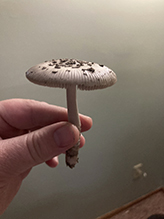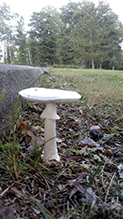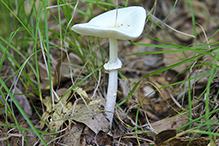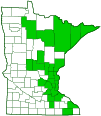False Death Cap
(Amanita citrina)
Conservation • Description • Habitat • Ecology • Distribution • Taxonomy
Conservation Status |
|
|||||||
| IUCN Red List | not listed |
|||||||
| NatureServe | not listed |
|||||||
| Minnesota | not listed |
|||||||
Description |
||
False Death Cap is a large, easily recognized mushroom that is mycorrhizal with hardwoods. It is common and widespread. The stalk is white or ivory white, smooth, 2½″ to 4¾″ tall, and The cap is smooth, dry, flat to convex, and 2″ to 4¾″ in diameter. There are two color variants that are not given taxonomic recognition as varieties, subspecies, or forms. On the yellowish variant the cap is pale greenish-yellow to yellowish-white when young, becoming mostly white or ivory white with pale greenish-yellow to yellowish-white just near the center as it ages. It has scattered, irregular, buff patches or warts, but these may disappear with age. It was formerly recognized as Gray False Death Cap (Amanita citrina var. grisea). On the white variant the cap is white when young and remains white as it ages. It has white patches or warts. It was formerly recognized as White False Death Cap (Amanita citrina var. alba). On both variants the patches or warts may disappear with age. Both variants are common in Minnesota. The gills are white, closely spaced, and are not attached to the stalk. They sometimes turn yellowish with age. The spores are white, cream, or yellowish. Although edible, most field guides list False Death Cap as poisonous due to its close resemblance to Death Cap. The darker variant has a strong odor of raw potato. The white variant has a mild odor. |
||
Similar Species |
||
Destroying Angel (Amanita bisporigera and Amanita virosa) is pure white throughout, both when young and when mature. The cup is sack-like. The cap usually does not have patches or warts. Coker’s Lavender Staining Amanita (Amanita lavendula) has a flush of lavender in the universal veil and sometimes lavender streaks on the cap. |
||
Habitat and Hosts |
||
Oak and pine forests. |
||
Ecology |
||
Season |
||
Summer and fall |
||
Distribution |
||||
|
Sources |
|||
| 7/18/2022 | ||||
Occurrence |
||||
Common and widespread |
||||
Taxonomy |
|||
| Kingdom | Fungi (Fungi) | ||
| Subkingdom | Dikarya | ||
| Phylum | Basidiomycota (Basidiomycete Fungi) | ||
| Subphylum | Agaricomycotina (Higher Basidiomycetes) | ||
| Class | Agaricomycetes (Mushrooms, Bracket Fungi, Puffballs, and Allies) | ||
| Subclass | Agaricomycetidae | ||
| Order | Agaricales (Common Gilled Mushrooms and Allies) | ||
| Suborder | Pluteineae | ||
| Family | Amanitaceae (Amanita mushrooms and allies) | ||
| Tribe | Amaniteae | ||
| Genus | Amanita (Amanita mushrooms) | ||
| Subgenus | Amanitina | ||
| Section | Validae | ||
| Series | Mappae | ||
Subordinate Taxa |
|||
Four North American subspecies of False Death Cap (Amanita citrina) have been described. White False Death Cap (Amanita citrina var. alba) is now considered a color variation of Amanita citrina. Gray False Death Cap (Amanita citrina var. grisea) now refers to Asian Citrine Bulbous Amanita, a variety that occurs only in Japan and China. Lavender False Death Cap (Amanita citrina var. lavendula) has been raised to species level, now Coker’s Lavender Staining Amanita (Amanita lavendula). Amanita citrina var. intermedia – no common name, has been raised to species level, and is now Amanita intermedia. It still has no common name. There are currently no recognized subspecies of Amanita citrina in North America. |
|||
Synonyms |
|||
Amanita citrina f. mappa Amanita citrina var. alba Amanita mappa |
|||
Common Names |
|||
Amanite Citrine False Death Cap Gray False Death Cap |
|||
Glossary
Mycorrhizal
A symbiotic, usually beneficial relationship between a fungus and the tiny rootlets of a plant, usually a tree.
Universal veil
An egg-like structure that envelopes all or most of a developing gill mushroom. Remnants of the universal veil sometimes visible on a mature mushroom are patchy warts on the cap, a ring on the stalk, and a volva at the base of the stalk.
Volva
Also called cup. A cup-like covering at the base of a mushroom stem, sometimes buried. It is the remnants of the universal veil ruptured by the mushroom pushing through. It is found on Amanita, Volvariella, and some other mushrooms.
Visitor Photos |
|||||
Share your photo of this fungus. |
|||||
| This button not working for you? Simply email us at info@MinnesotaSeasons.com. Attach one or more photos and, if you like, a caption. |
|||||
AGShep |
|||||
I have found many of these in my backyard at the edges of the trail through my backwoods. |
|||||
 |
 |
||||
Brad Johnson |
|||||
 |
 |
||||
Scott Schad |
|||||
Shorter one cupped up this morning, tall one still holding rain water from two days ago. The one coming up I assume is the same? … |
|||||
 |
 |
||||
MinnesotaSeasons.com Photos |
|||||
Yellowish variant |
|||||
 |
 |
||||
 |
|||||
White variant |
|||||
 |
 |
||||

Slideshows |
||

Visitor Videos |
|||
Share your video of this mammal. |
|||
| This button not working for you? Simply email us at info@MinnesotaSeasons.com. Attach a video, a YouTube link, or a cloud storage link. |
|||
Other Videos |
|||


Last Updated:



